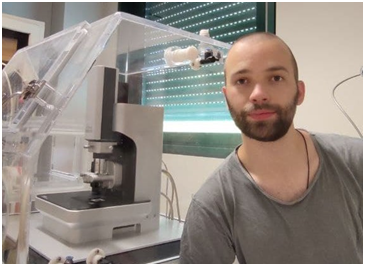
Giorgio Cortelli
Giorgio Cortelli is currently a PhD student at the Department of Civil, Chemical, Environmental and Materials Engineering, XXXV Cycle, in the University of Bologna with a focus on Structural and Geotechnical Engineering studies.
During his studies at Alma Mater Studiorum, University of Bologna, he conducted his thesis work on ”Micro-lever calibration for AFM and Force Spectroscopy applied to polymer nanofibers” at the AFM Laboratory of DIFA. In October 2017, he received his Bachelor´s Degree in Physics.
Two years later, Giorgio earned his Master's Degree in Physics at the same university,with the master thesis on "Ultrafast Electron Diffraction on materials exposed to intense Free Electron Laser pulses," which was a result of the experimental activity carried out at the international research center Elettra-Sincrotrone Trieste.
Currently, Giorgio’s research activity is concentrated on nanomechanical characterization of stretchable conductive surfaces
1. Please summarize the research you do and explain why it is significant?
My research project focuses on nanomechanical characterization of stretchable conductive surfaces such as the double layer PDMS/Au. On one hand, I carry out experiments by means of AFM. Typical measurements are force spectroscopy, non-contact mode, conductive AFM and PinPointTM. On the other hand, I perform numerical simulation and modeling to figure out what are the main parameters that play a role in the experiments and how they are correlated. Stretchable conductors make electronics mechanically compliant with the human body. The mechanical and electrical characterization of stretchable conductors is crucial in order to develop stretchable electronics such as wearable or implantable sensors. Finding an interpretative and predictive model paves the way to systematic analysis and design of stretchable devices.
2. How might your research be used?
We developed an AFM-based procedure supported by a linearized model to investigate the nanomechanics of PDMS/Au. We found that the interface between the two layers is diffused as the metallic particles permeate in the substrate during evaporation. From the stiffness-thickness curves we estimated the elastic modulus and the effective thickness of an ultrathin metallic film deposited on a polymeric substrate. This quantitative information about the effective thickness is crucial in the stretchable devices design as it is directly correlated to the bending stiffness of the stretchable conductors. Furthermore, this characterization method is of fundamental importance to study the system in its conditions of use, i.e. under strain. We are now focusing on correlating mechanical and electrical properties at different strains via the Conductive PinPointTM AFM.
3. Why is the Park AFM important for your research?
Park AFM is a suitable tool for my research as it allows me to probe the local mechanical and electrical properties of my samples. The precision of positioning in the sample plane and of the measurement of the variations in heights, combined with a very thin tip, allow to investigate the formation of micro-cracks in the conductive thin film under the strain. This allows us to study how morphology and strain impact the electrical properties of the material.
4. What features of Park AFM are the most beneficial and why?
I believe that the most beneficial feature of Park AFM is the Conductive PinPointTM Mode. This experimental technique makes it possible to map at high resolution and simultaneously mechanical and electrical properties of the sample. In this way it is possible to study the correlation. This is of crucial importance for developing materials that are mechanically stretchable and electrically conductive.
